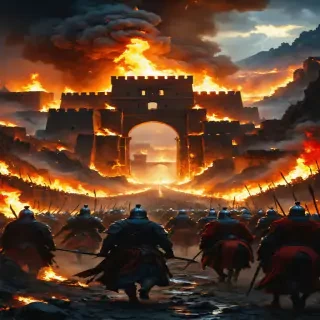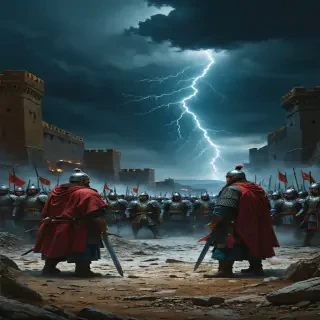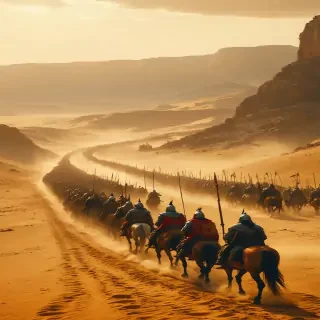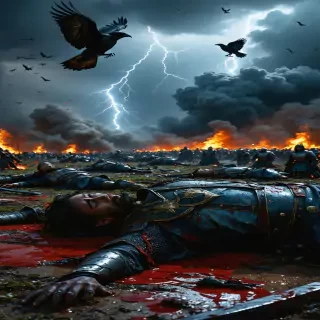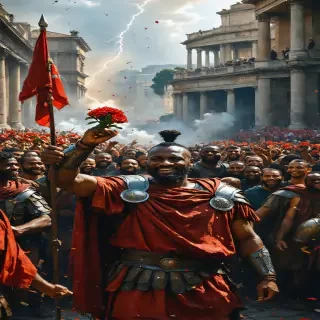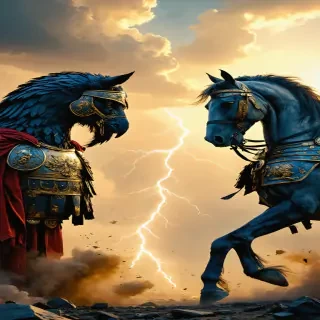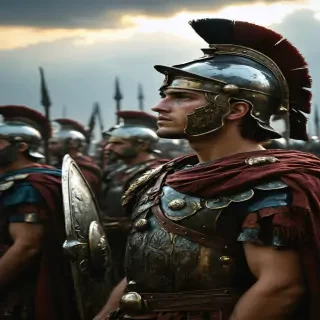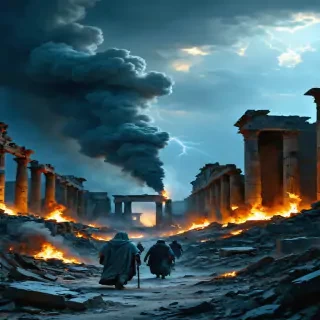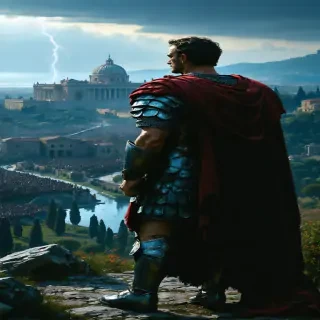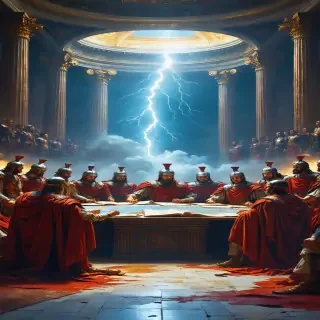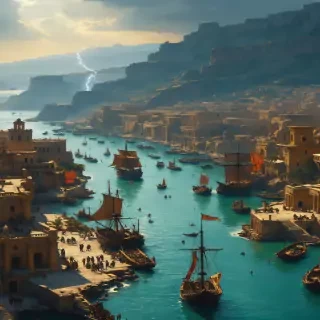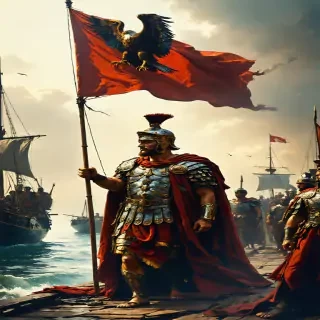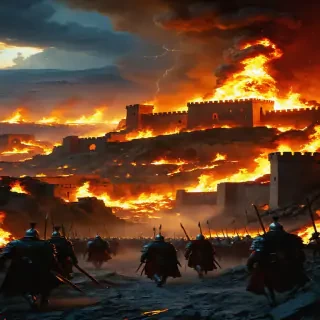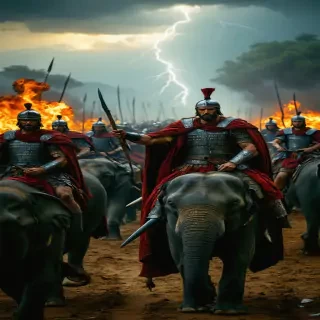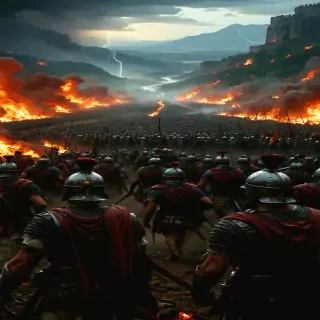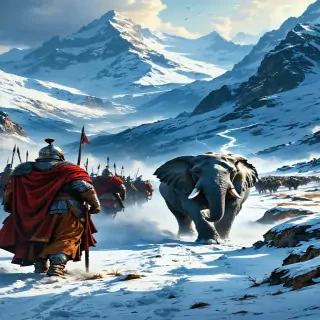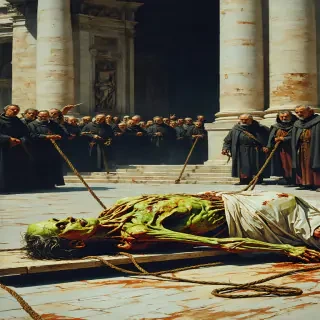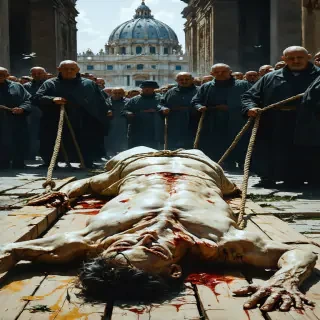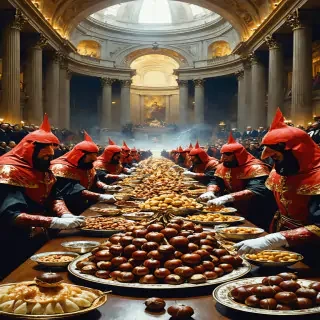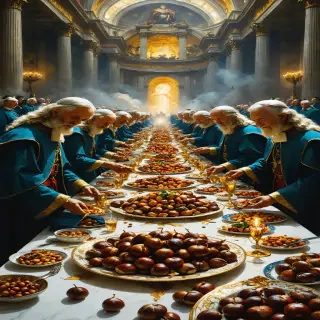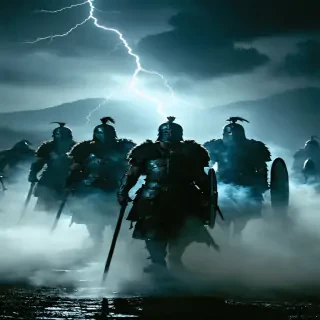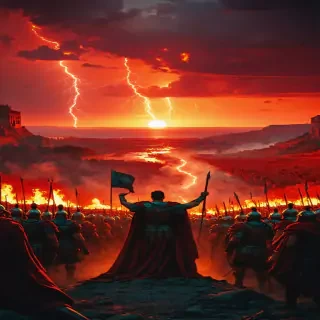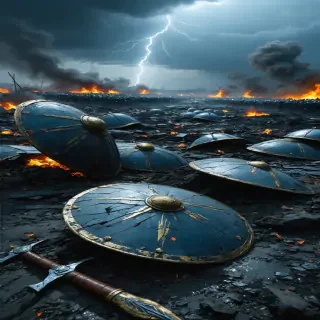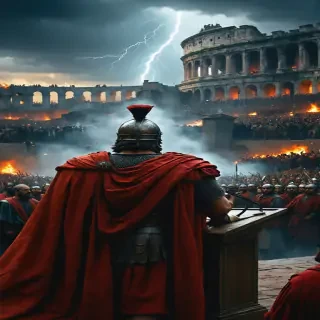"The fall of Merv, with Mongol warriors storming through the gates, fires consuming the city, and people fleeing in terror."
"A dramatic scene of Merv’s leaders negotiating with Mongol generals at the city gates, under a tense and ominous atmosphere."
"The Mongol army marching toward Merv, their banners flying high, with endless rows of soldiers and horses crossing the desert."
"A grim depiction of Mongol justice, with prisoners lined up for execution under Genghis Khan’s watchful gaze."
"The aftermath of a battle, with fallen warriors lying on a blood-stained field as crows circle above."
"A Carthaginian merchant ship navigating stormy seas, symbolizing the city’s wealth and maritime power before the wars."
"Scipio Africanus receiving a hero’s welcome in Rome, with crowds cheering and flowers thrown in his path."
"A symbolic representation of Rome and Carthage, with a Roman eagle and a Carthaginian horse locked in combat."
"A young Roman soldier gazing at the horizon, dreaming of victory as his comrades prepare for battle."
"The ruins of Carthage after its destruction, with smoke rising and survivors wandering through the desolation."
"A fiery naval engagement, with Roman corvus boarding devices clamping onto Carthaginian ships, and soldiers battling on the decks."
"Hannibal standing on a hilltop overlooking Rome, his army visible in the distance, as he contemplates his next move."
"A council of Roman senators debating strategies for defeating Carthage, surrounded by maps and scrolls in a grand hall."
"A Carthaginian harbor bustling with trade, showing the city’s wealth before the devastation of the Punic Wars."
"Hannibal’s army ambushing Roman forces in a dense forest, with elephants charging through the trees."
"A symbolic depiction of a Roman consul commanding his fleet, with the Roman eagle standard flying high above the ships."
"The final siege of Carthage, with the city engulfed in flames, walls crumbling, and Roman soldiers advancing through the ruins."
"Scipio Africanus directing Roman cavalry in the Battle of Zama, with Carthaginian elephants retreating in fear."
"The Battle of Cannae, showing Carthaginian forces encircling and overwhelming Roman legions on a blood-soaked battlefield."
"Hannibal leading his army and war elephants across the snow-covered Alps, with soldiers struggling against the icy terrain."
"A dramatic naval battle during the First Punic War, with Roman and Carthaginian ships clashing in rough seas, surrounded by flames and chaos."
Noah and his family loading the Ark. Each member is seen leading or carrying animals into the vessel. The animals are diverse, with realistic textures and expressions. The family wears simple robes, and their expressions show a mix of exhaustion and determination. The background features storm clouds slowly forming.
Noah and his family loading the Ark. Each member is seen leading or carrying animals into the vessel. The animals are diverse, with realistic textures and expressions. The family wears simple robes, and their expressions show a mix of exhaustion and determination. The background features storm clouds slowly forming.
"A solemn scene of the Holocaust survivors arriving in Palestine, symbolizing hope and tragedy intertwined."
A grotesque depiction of Borgia's corpse. The body is bloated and discolored, lying on a simple plank. Figures in the background use ropes to drag the corpse into the imposing entrance of Saint Peter’s Basilica.
A grotesque depiction of Borgia's corpse. The body is bloated and discolored, lying on a simple plank. Figures in the background use ropes to drag the corpse into the imposing entrance of Saint Peter’s Basilica.
A decadent feast known as the "Banquet of Chestnuts" in a grand Vatican hall. Dozens of cardinals sit at a long table laden with extravagant food. Naked courtesans crawl on the floor, collecting chestnuts while participants watch with expressions of indulgence and debauchery.
A decadent feast known as the "Banquet of Chestnuts" in a grand Vatican hall. Dozens of cardinals sit at a long table laden with extravagant food. Naked courtesans crawl on the floor, collecting chestnuts while participants watch with expressions of indulgence and debauchery.
A haunting depiction of the Gallic tribes defeated, with shadowy figures representing their lost culture and pride.
The Roman legions celebrating their victory, with Caesar delivering a triumphant speech under a blood-red sunset.
A desolate battlefield outside Alesia, littered with broken shields, weapons, and the bodies of fallen warriors.
The execution of Vercingetorix in Rome, with a cheering crowd and a grim Caesar watching from a podium.
Lorem ipsum dolor sit, amet consectetur adipisicing elit. Deleniti esse reprehenderit voluptates obcaecati placeat architecto hic ratione ducimus nemo.
Lorem Ipsum is simply dummy text of the printing and typesetting industry. Lorem Ipsum has been the industry's standard dummy text ever since the 1500s, when an unknown printer took a galley of type and scrambled it to make a type specimen book. It has survived not only five centuries, but also the leap into electronic typesetting, remaining essentially unchanged. It was popularised in the 1960s with the release of Letraset sheets containing Lorem Ipsum passages, and more recently with desktop publishing software like Aldus PageMaker including versions of Lorem Ipsum.
It is a long established fact that a reader will be distracted by the readable content of a page when looking at its layout. The point of using Lorem Ipsum is that it has a more-or-less normal distribution of letters, as opposed to using 'Content here, content here', making it look like readable English. Many desktop publishing packages and web page editors now use Lorem Ipsum as their default model text, and a search for 'lorem ipsum' will uncover many web sites still in their infancy. Various versions have evolved over the years, sometimes by accident, sometimes on purpose (injected humour and the like).
Contrary to popular belief, Lorem Ipsum is not simply random text. It has roots in a piece of classical Latin literature from 45 BC, making it over 2000 years old. Richard McClintock, a Latin professor at Hampden-Sydney College in Virginia, looked up one of the more obscure Latin words, consectetur, from a Lorem Ipsum passage, and going through the cites of the word in classical literature, discovered the undoubtable source. Lorem Ipsum comes from sections 1.10.32 and 1.10.33 of "de Finibus Bonorum et Malorum" (The Extremes of Good and Evil) by Cicero, written in 45 BC. This book is a treatise on the theory of ethics, very popular during the Renaissance. The first line of Lorem Ipsum, "Lorem ipsum dolor sit amet..", comes from a line in section 1.10.32.
The standard chunk of Lorem Ipsum used since the 1500s is reproduced below for those interested. Sections 1.10.32 and 1.10.33 from "de Finibus Bonorum et Malorum" by Cicero are also reproduced in their exact original form, accompanied by English versions from the 1914 translation by H. Rackham.
There are many variations of passages of Lorem Ipsum available, but the majority have suffered alteration in some form, by injected humour, or randomised words which don't look even slightly believable. If you are going to use a passage of Lorem Ipsum, you need to be sure there isn't anything embarrassing hidden in the middle of text. All the Lorem Ipsum generators on the Internet tend to repeat predefined chunks as necessary, making this the first true generator on the Internet. It uses a dictionary of over 200 Latin words, combined with a handful of model sentence structures, to generate Lorem Ipsum which looks reasonable. The generated Lorem Ipsum is therefore always free from repetition, injected humour, or non-characteristic words etc.
